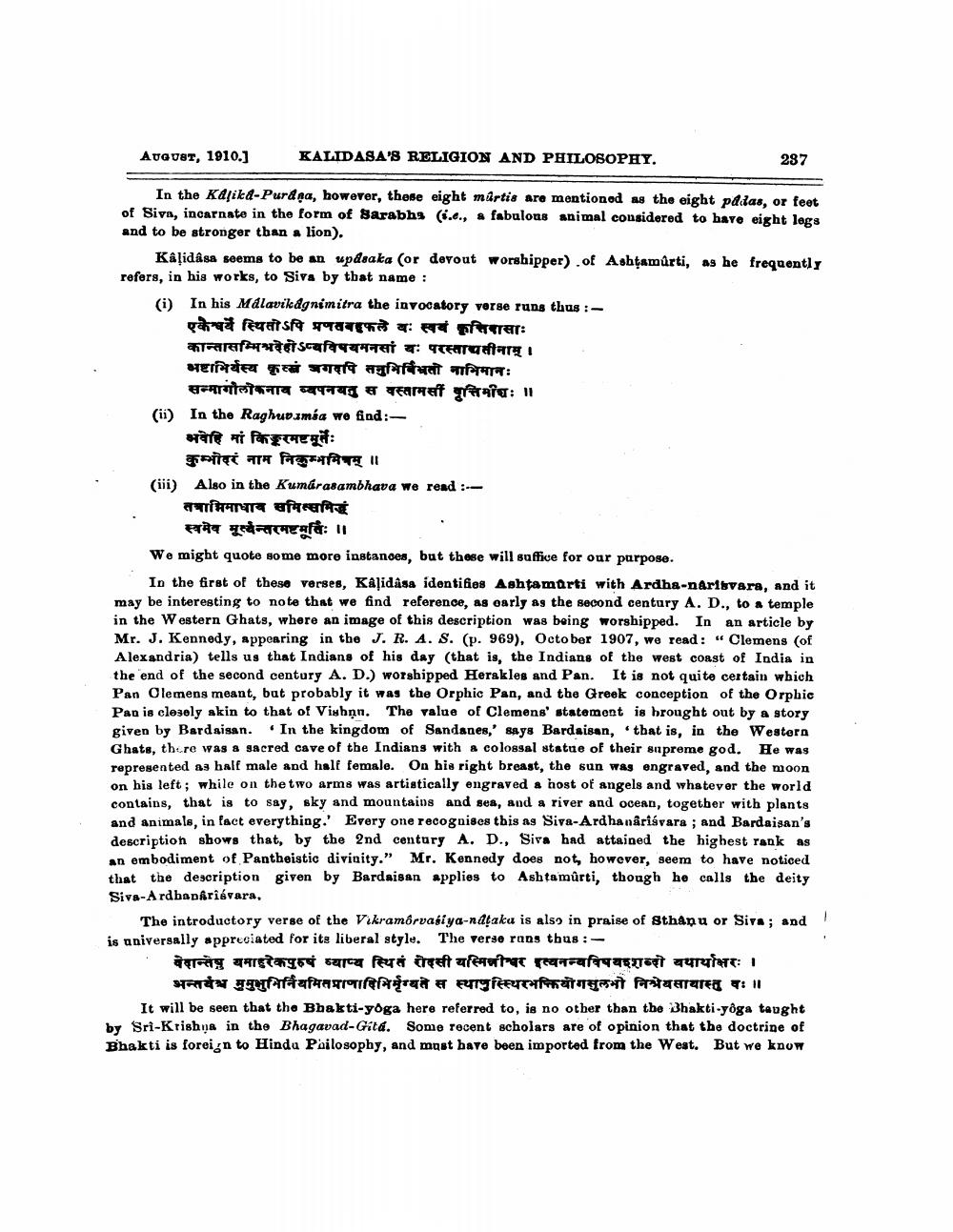________________
AUGUST, 1910.]
KALIDASA'S RELIGION AND PHILOSOPHY.
In the Kalika-Purana, however, these eight martis are mentioned as the eight padas, or feet of Siva, incarnate in the form of Sarabhs (.e., a fabulous animal considered to have eight legs and to be stronger than a lion).
Kalidasa seems to be an upasaka (or devout worshipper) of Ashtamûrti, as he frequently refers, in his works, to Siva by that name :
(i) In his Malavikagnimitra the invocatory verse runs thus :एकेश्वर्ये स्थितोऽपि प्रणतबहुफले वः स्वयं कृत्तिवासाः कान्तासम्मिश्रदेहोऽन्यविषयमनसां यः परस्ताद्यतीनाम् । अष्टाभिर्यस्य कृत्खं जगदपि तनुभिर्बिभ्रतो नाभिमानः सम्मागौलोकनाव व्यपनयतु स वस्तामस वृत्तिमांशः ॥ (ii) In the Raghuvamia we find:
segurgit:
कुम्भोदरं नाम निकुम्भमित्रम् ॥
(iii) Also in the Kumarasambhava we read :
तत्राभिमाधाव समित्समिद्धं
287
Evite yoksacurgft: 11
We might quote some more instances, but these will suffice for our purpose.
In the first of these verses, Kâlidâsa identifies Ashtamurti with Ardha-narisvara, and it may be interesting to note that we find reference, as early as the second century A. D., to a temple in the Western Ghats, where an image of this description was being worshipped. In an article by Mr. J. Kennedy, appearing in the J. R. A. S. (p. 969), October 1907, we read: "Clemens (of Alexandria) tells us that Indians of his day (that is, the Indians of the west coast of India in the end of the second century A. D.) worshipped Herakles and Pan. It is not quite certain which Pan Clemens meant, but probably it was the Orphic Pan, and the Greek conception of the Orphic Pan is closely akin to that of Vishnu. The value of Clemens' statement is brought out by a story given by Bardaisan. In the kingdom of Sandanes,' says Bardaisan, that is, in the Western Ghats, there was a sacred cave of the Indians with a colossal statue of their supreme god. He was represented as half male and half female. On his right breast, the sun was engraved, and the moon on his left; while on the two arms was artistically engraved a host of angels and whatever the world contains, that is to say, sky and mountains and sea, and a river and ocean, together with plants and animals, in fact everything.' Every one recognises this as Siva-Ardhanarisvara; and Bardaisan's description shows that, by the 2nd century A. D., Siva had attained the highest rank as an embodiment of Pantheistic divinity." Mr. Kennedy does not, however, seem to have noticed that the description given by Bardaisan applies to Ashtamûrti, though he calls the deity Siva-Ardhanariavara,
1
The introductory verse of the Vikramôrvasiya-naṭaku is also in praise of Sthaņu or Siva; and is universally appreciated for its liberal style. The verse rans thus:
वेदान्तेषु यमाहरेकपुरुषं व्याप्य स्थितं रोदसी यस्मिन्नीश्वर इत्यनन्यविषयश्शब्दो यथार्थाक्षरः । भन्तबंध सुनिर्नियमितपणादिनिर्मृग्यते स स्वानुस्थिरभक्तियोग निषेवसायास्तु वः ॥
It will be seen that the Bhakti-yoga here referred to, is no other than the Bhakti-yoga taught by Sri-Krishna in the Bhagavad-Gitá. Some recent scholars are of opinion that the doctrine of Bhakti is foreign to Hindu Philosophy, and must have been imported from the West. But we know




